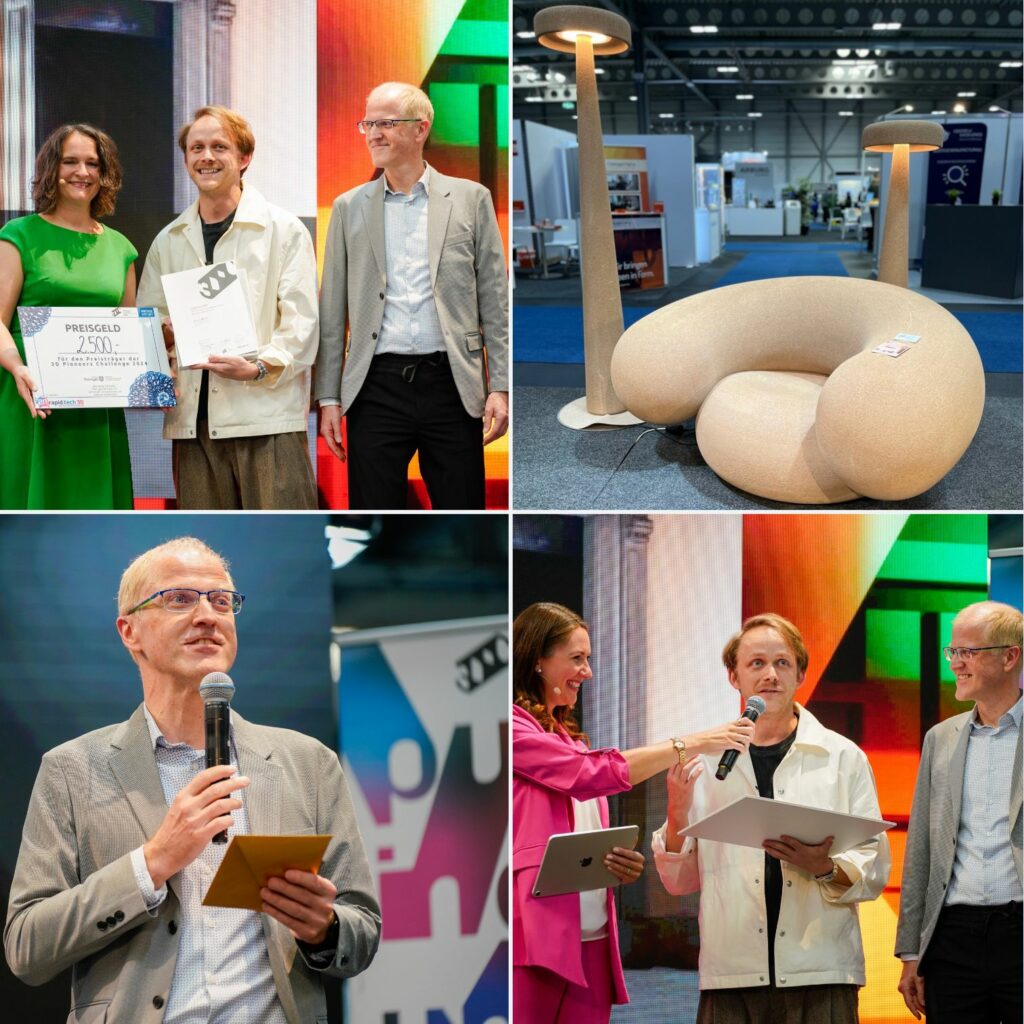
On May 15, the 3DPC awards were presented at RapidTech 3D in Erfurt. The Technical and Scientific Director of the IAM3DHUB, Magí Galindo, collaborated as a jury member in the awards that englobe different categories and ended up winning 3D Printed Electronic Skin, from Texas A&M University.
The exhibition and award ceremony of the international competition for additive manufacturing and advanced technologies took place for the ninth time as part of Rapid.Tech 3D and was once again a crowd magnet. For the 20th time, Messe Erfurt offered a platform for the industry and was able to provide significant impetus.
Exciting innovations from all over the world were on show in the special area of the 3D Pioneers Challenge. Submissions from 25 countries and 5 continents faced the international jury. 43 finalists presented their latest projects. Young start-ups, universities and established companies came together. The Technical and Scientific Director of the IAM3DHUB, Magí Galindo, collaborated as a jury member in the awards.
In line with this year’s call for entries, the projects showed how ground-breaking innovations can be created with a “collaborative mindset” in particular in order to create opportunities for business, industry and sustainability.
The industrial “vibe” could be felt at the trade fair stand. Large-format exhibits made of metal and wood were on display next to live printing industrial printers. For fashion lovers, there were also several projects on the booth this year. Dutch FashionTech designer Anouk Wipprecht reached the final with her Chromatic Dress, whose LEDs react to movement. The category winner was the British team around “Balena X Variable Seams“, whose fashion concept with its delicate and filigree realisation represents the potential of AM and at the same time demonstrates the fashion industry alternative solutions for circular design.

Another highlight was the winner in “Material“, which also impressed in the cross-category focus “Sustainability“. The innovative start-up WILLOWPRINT from Germany produces printable material from wood waste and manufactures sustainable seating that can be recycled.

The applications ranged from nanostructure to large-format printing. In addition to glass lenses for solar elements, the largest 3D building in Europe printed on site in Heidelberg was also presented. WAVEHOUSE was the winner in the “Architecture” category. Artificial intelligence is also conquering 3D printing. Visitors were able to watch at the presentation of the team “Sketchurizer”, how 3D objects are created from sketches.

For the first time, the “Electronics” category was able to represent the main winner. “3D Printed electronic Skin” gave goose bumps: Akilesh Gaharwar joined the hybrid award ceremony at the 3DPC stand from the USA live via video conference. The jury was convinced: advanced technologies such as AI, robotics and additive manufacturing should enable a future in which people take the centre stage. “E-Skin will enrich our lives as an interface between man and machine.” E-Skin imitates the flexibility and sensitivity of human skin. The applied hydrogels can recognise stretching, pressure or temperature changes and are intended to serve as a motion sensor, voice recognition system, touchpad or thermometer. This is a significant advancement and offers promising applications in robotics, wearables and healthcare.

Lukas Dechau from the HFG Karlsruhe was honoured as “Best Student Project” with “Rock Solid“, which demonstrates his specially developed 3D printing process for producing objects from “exposed aggregate concrete” without support structures and excess material.

The “Design” category was won by Virginia San Fratello’s “WUIware” project from the USA, whose material is made from the ashes of forest fires in California. In “Digital“, the project around the open-course platform “PicoGK- dual metal AM” from Dubai was the winner. They aim to make it easier for engineers to design their developments with unprecedented performance. The platform makes digital tools with libraries ranging from artificial intelligence-supported structures to quasi-crystals freely available to everyone.

The Spanish company Reinforce3D was awarded in “Machinery” with their “Satellite Antenna Structure by CFIP“. The new construction technology inserts continuous carbon fibers into 3D printed tubes to reinforce them. “Fidentis“, a Munich-based start-up, won in the “MedTech” category. The jury was impressed by its scalable potential, which offers a cost-effective solution to make expensive dental treatments accessible to a wider audience.

“EconitWood” from “additive tectonics” convinced in the “Industrial” category, which was announced for the first time. The German team rethinks the recycling of wood scraps for large-format architectural products and impressed the judges with this sustainable and scalable solution for the architectural industry.

Prizes worth over 175.000 EUR in total were awarded. The entire prize money totalling 35.000 EUR was provided by the Thuringian Ministry of Economics, Science and Digital Society. In addition to the 10.000 EUR prize money, the main prize winner received the limited 3DPC Trophy. The winners also received software licenses from nTop, 3YOURMIND and CASTOR, coaching from AM Ventures and 10xDNA, as well as 3D printers from Formlabs and UltiMaker/MakerBot. The partner Autodesk awarded three Special mentions. Av edition, the publishing house for architecture and design, rounded off the prize packages with book prizes.
The 20th anniversary of Rapid.Tech3D was celebrated at the gala evening in the Kaisersaal. Minister for Ecomonic Wolfgang Tiefensee and trade fair managing director Michael Kynast honoured the award winners in a festive setting on the evening of the second day of the trade fair, 15 May.
Press release developed by 3D Pioneers Challenge. You can read the whole article here.

